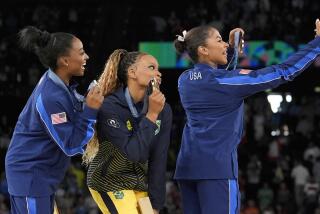Checking Neutrality at Door
Because it is our good fortune to share oxygen with Zeke (The Geek) Mowatt, Victor (The Sham I Am) Kiam and the rest of the New England Neanderthals, we are now reacquainted with an ongoing issue that most often gets buried under the daily pile of adhesive tape, jock straps and $20 autographed baseball cards.
For as long as there have been sportswriters and professional athletes, there has been harassment of sportswriters by professional athletes. The locker room, allegedly, is neutral territory, but anyone on the note-pad side of the arrangement knows this is nonsense.
The basic thought process, once you’ve been allowed into the inner sanctum, is this: Shift out of neutral, shift into overdrive and get the hell out.
The recent episode involving Boston Herald reporter Lisa Olson and five naked and very brave Patriots is many things--detestable, reprehensible, an outrage--but one thing it is not, is new. Olson’s case may be an extreme example of the form, but in some way or shape, this kind of degradation is practiced in the dressing rooms and clubhouses of America on a regular basis.
Two weeks ago, Olson was cornered in the New England locker room by Mowatt and his supporting cast, who thrust their genitals in her face and taunted, “Is this what you want?” To the general population, this is horrifying, but to the pro athlete who checks his sense of decency into the same valuables box as his gold chains, this is amusement.
Olson’s story is the latest in a long, sorry line, but it wound up in national headlines, partly because she chose to fight back through the media and partly because:
a) Kiam, the blunt-edged razor who runs the Patriots, reached world-record levels of stupidity and insensitivity with his response to the incident. Kiam allegedly called Olson “a classic bitch,” the episode “a flyspeck in the ocean” and accused newspapers of “asking for trouble” by sending female reporters into locker rooms.
b) Kiam made an incredibly insincere attempt at damage control, which consisted of enlisting a Madison Avenue flack to plant full-page apologies in New York and Boston newspapers, which were nothing more than subliminal advertisements to “Please, keep buying my Remington blades.”
c) It happened along the Northeastern seaboard, where anything that happens in New York or Washington D.C. or Boston is inherently more significant than anything that happens anywhere else. This is why George Argyros, for years, was allowed to run the Seattle Mariners into the ground in peace while George Steinbrenner’s missteps were treated as if they were Nazi war crimes.
Since Kiam can’t keep from falling on his face and since the East Coast tabloids got bored once the Mets slipped from the race, the story continues to grow and mutate, sprouting new spinoffs by the day.
NFL Commissioner Paul Tagliabue announces a full-scale investigation into the matter. Women’s groups organize protests, boycotts and other counterstrikes. Cincinnati Bengal Coach Sam Wyche bars a woman reporter from his locker room after Monday night’s loss to the Seattle Seahawks.
If the real issue here is a woman’s rights as a journalist inside a locker room, there is no issue at all. Women should have equal access. They should have equal protection. They should also be able to vote and to breathe.
Next.
No, the real problem rests with the locker room itself. In short, it is a terrible place to conduct the business of gathering the news.
Little of actual substance or insight is gained in the traditional postgame process. When was the last time you had a meaningful discussion about the existence of a higher being while pulling on your underwear? After a game, players primarily want to go home. So they answer questions as quickly and as simply as possibly--hence, the birth of the cliche--and they do so while buttoning collars, slipping on socks, tying shoelaces and hurrying out the door.
Baseball is worse than the others because, with the exception of the last half-hour before game time, the locker room is always open. This gives players more reason to resent the intrusion--and more time to concoct mature, thoughtful methods on how to deal with it.
Dave Kingman sends a rat to a woman sportswriter. Willie Hernandez dumps a bucket of ice over the head of a columnist. Bert Blyleven lights firecrackers and rolls them into unsuspecting packs of reporters. The New York Yankees pitch in and buy a woman sportswriter a pink-frosted cake baked in the shape of naked maleness.
Long before Lisa Olson, the Angels had a designated hitter, a highly paid designated hitter, who used to strip and strut at the sight of a female reporter in the clubhouse, sauntering slowly by, back and forth, just to make sure she noticed. It was the same strain of Zeke Mowatt-type intimidation, only more subtle. With Blyleven, the Renaissance right-hander, nothing is subtle. The clubhouse is his domain, his playhouse--Pee-Wee’s Playhouse, intellectually speaking--and he goes to great, often unprintable lengths to terrorize women sportswriters brazen enough to disrupt his special brand of male bonding.
So let the Mowatts and the Blylevens and the other little minds have their own little worlds. Create a true neutral zone, an interview room, and let the writers meet the athletes there. Tennis has done this for decades. Sometimes the players come in right off the court, sometimes they shower and dress first, but they do come in and they do talk, giving all reporters, male and female, equal access.
And what about the need for longer, one-on-one interviews? Copy tennis again. Set up the interviews in advance. This is not difficult. It can be done.
Cut a deal. The athletes get back their privacy, the writers get back their dignity--and their safety.
More to Read
Go beyond the scoreboard
Get the latest on L.A.'s teams in the daily Sports Report newsletter.
You may occasionally receive promotional content from the Los Angeles Times.










